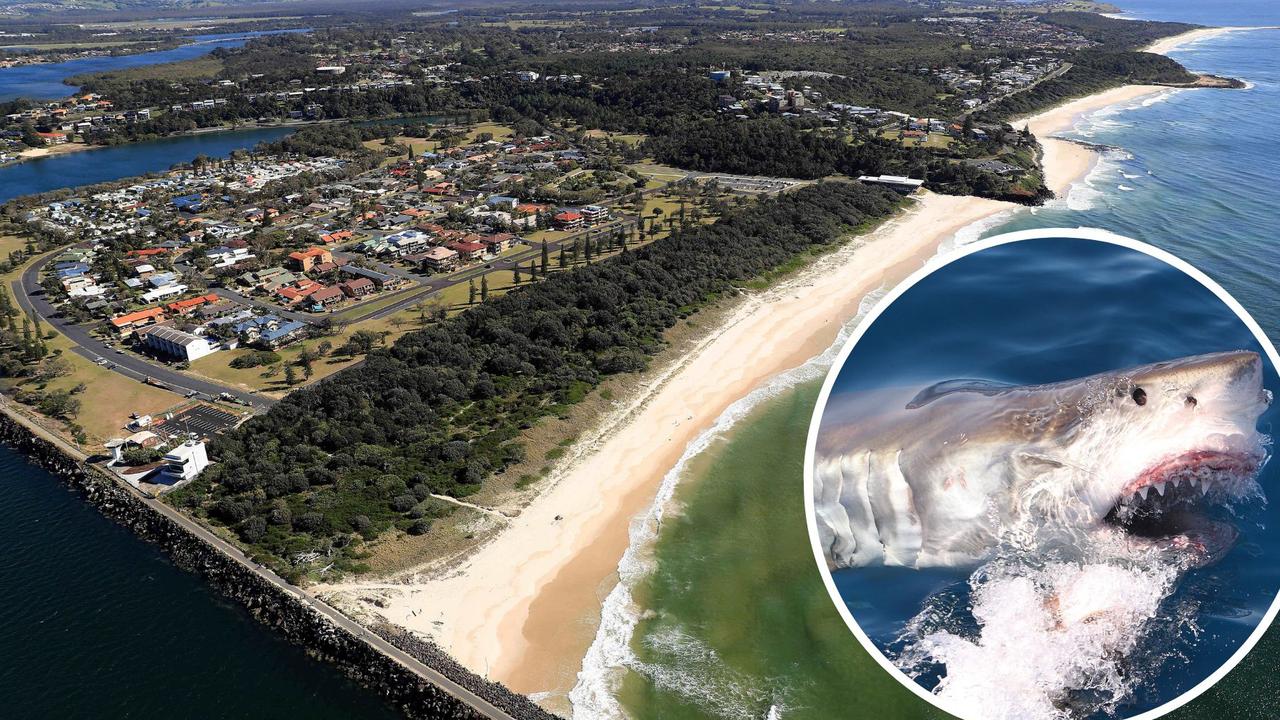Ballina shark attacks: What caused string of maulings, how can it be prevented from happening again
A northern NSW tourist town was shaken by a series of shark attacks – but they ceased as quickly as they began. Now, science has shed more light on the horrifying incidents.

Scientists have shed light on oceanic currents and other natural occurrences which may have led to a series of terrifying shark attacks that rocked the North Coast tourist town of Ballina.
It can also be revealed that the number of sharks congregating off northern NSW is no less today than what it was a few years back when the ocean waters turned red with blood.
Ballina, about 720km north of Sydney and 185km south of Brisbane, gained international infamy amid attacks at Lighthouse Beach, Shelly Beach and along the North Coast in 2015-16.
The world took notice when Japanese national Tadashi Nakahara was killed by a great white at Shelly Beach in Ballina on February 9, 2015 – less than 24 hours after Jabez Reitman was stalked and mauled at Seven Mile Beach in Byron Bay.
Bodyboarder Mathew Lee was then attacked off Lighthouse Beach on July 2, 2015, suffering horrific injuries to both legs.

Sam Morgan was mauled on his left thigh while surfing Lighthouse Beach on November 10, 2015 – less than a year before Cooper Allen was attacked at the beach on September 26, 2016. Cooper, 17, fought off a 4m long great white.
Ballina surfer Dan Webber was just 5m away from Cooper when he saw a dark shadow in the face of a wave.
“A few seconds later, I heard a shout and then saw the nose of a board sailing through the air,” he said.
“I jumped over the wave and looked over to where the attack happened, half expecting to see a dismembered body.
“I saw Cooper swimming backwards, away from the shark.
“The shark stopped about five metres from Cooper and was thrashing with the board still in its mouth.”
It was like a scene out of Jaws, Mr Webber said, speaking of “the third shark attack at that beach in a year”.
Ballina became shark attack central.
Eyes across the globe turned in morbid fascination to the usually laid-back coastal haven about 30km east of Lismore to watch the carnage unfold.
“It certainly had a negative effect on a lot of people (in the community),” former Ballina Shire mayor David Wright said.
“Maybe because Ballina was in the news for all the wrong reasons.”

News crews from far and wide drove around Ballina hunting for sought-after interviews and photos with shark attack survivors and their families as the number of bites grew.
Amid the media spectacle, the community was reeling following the death of beloved locals like Tadashi, and the wounding of Matt Lee.

“Virtually all the surfers that were in the water with Tadashi didn’t get back in the water,” Mr Wright said.
Most of the men who pulled Tadashi out of the water and tried to save him as he bled out on the beach were left traumatised.
“We had a meeting with them the next weekend (after Tadashi was killed) and it was like sitting at a death camp or something because everyone had hollow eyes,” Mr Wright said.

The spike in shark attacks took a brutal toll on Ballina’s economy, which is heavily dependent on the tourist trade during the summer months and school holidays.
Mr Wright said holiday makers “knocked” trips to Ballina and Lennox Head on the head.
“People had been coming to Ballina on holiday for 30 years and they just stopped coming,” he said.
“During that 2015 Christmas and 2016, surfboard manufacturers went from selling 30 a month down to two or three.”
Mr Wright was mayor of Ballina Shire for 11 years and on the front lines trying to get his head around and deal with the devastating influx of beach bites.
He said the attacks changed the way the community used the beach completely, for a time at least.
“As mayor I played it down so people would still come, but a lot of people wouldn’t come,” he said.

“That’s why I was so desperate to get government support,” he said.
Mr Wright led the charge to fast-track shark protection and mitigation measures as fears grew following the carnage, which marked some of the most concerning shark activity globally.
He worked with the state government and the NSW Department of Primary Industries each day throughout the crisis to create world-leading bay protection systems.
“At one stage we had nine per cent of the whole world’s shark interactions,” Mr Wright said.
“Now that wasn’t all bites – people knocked off boards and all sorts of stuff.”
Millions of dollars was pumped into the largest shark investigation in the world at the time.
“Virtually every technology that was available we worked with,” Mr Wright said.

“This was such a big part of my life, and fighting the government to do something about it.”
There are now 37 shark listening stations and 20 smart drum line regions, along with drones on 50 beaches along the entire NSW coast dedicated to detecting sharks before they strike.
The department has now tagged about 962 white sharks, 314 tiger, and 165 bull sharks.

“It just opens your eyes to the number of sharks that are swimming along our beaches, that will pass our beaches on any given day,” Dr Paul Butcher said.
Dr Butcher is principal research scientist of the department’s fisheries branch.
He said Ballina’s ordeal, which resonated across the world, cemented it as the proving ground for pioneering shark mitigation research and technology.
“We went through a series of trials between drones, smart drum lines, shark listening stations – so that they’re all in place permanently as operational type bay protection tools,” Dr Butcher said.
Raised in Grafton, Dr Butcher spends half of each year out on the water off the North Coast doing field research.
One of his key jobs is to come up with new ways to stop sharks from taking a bite out of hapless swimmers, surfers and other beachgoers close to home and further afield.

New technology for bay protection
The department shark mitigation program Dr Butcher is working on has funding for the next four years and includes research across the NSW coast.
But the Ballina region is where it all started and it is still a major part of innovations in shark protection, Dr Butcher said.

The department has been taking weekly water samples at Ballina and Evans Head for the past two years, and the environmental DNA gathered is being used to develop the next stage of shark mitigation.
“We might not have to tag sharks in the future,” Dr Butcher said.
“We can just take a water sample and be able to detect presence and absence of what we call danger sharks – bulls, tigers and white sharks.

“We’re also cross referencing that now and looking at the other animals that are in the water at the same time.
“So we can use the E-DNA for dangerous sharks’ prey species in the water to try and see if we can get some sort of link as to why they’re there.”
“The future is going to be able to detect (sharks) without actually seeing them.”
Why did the sharks attack?
The East Australian Current is also a dominant factor that determines what moves and where along the East Coast of Australia, Dr Butcher said.
“There’s definitely a study that has reported that there was a stronger than normal East Australian Current in 2015,” he said.
“And they concluded that this may have caused white sharks to move into cooler waters closer to the coastline during that time period, which would end up increasing the likelihood of interactions with water users.
“Great white sharks certainly like temperatures between 18 and 22 degrees and when that East Australian Current runs really hard, it traps the cold water along the coast and we might see great whites along the coast for longer periods.”
The current doesn’t just push sharks closer to the coast, but also the marine life that the white sharks prey on.
Sharks travel in a relaxed ‘cruise-control’ mode, and only become dangerous when they’re in feeding mode, Dr Butcher said.

A lot of the shark attacks in Ballina during 2014-16 occurred when there was an influx of marine life near shore.
Ballina surfer Dan Webber reported seeing dolphins, a school of fish and a stingray swim past him when he was surfing near Cooper Allan before he was attacked by a great white shark.
Where did the sharks go?
Great whites can travel between 30,000km and 40,000km over a three-year period.
July through to November is considered the main shark season – which is when the majority of shark attacks happened in Ballina.
In 2022, the department reported a lower catch rate than in previous years.
“Talking to the contractors at Ballina and seeing the actual catches of white sharks this season, it’s significantly less than what we’ve seen in previous years,” he said.

The sharks are still there, they are just not coming as close to shore.
The reduction in catches has coincided with the instalment of smart drum lines down the coast.
When white sharks are tagged and released as part of the smart drum line program to the south at Port Macquarie or Coffs Harbour, they usually swing out to sea in a 15-20km or so arch offshore before returning to their previous path.
“An artefact of that is probably that the animals have been caught before they get to that region,” Dr Butcher said.
The smart drumlines could be temporarily disrupting the natural migration pattern of the sharks.
But Dr Butcher said it’s still largely a mystery – and will likely remain a mystery – as to why the sharks attacked beachgoers so frequently between 2014 and 2016.

“That’s one thing that we can’t predict, is when the shark attacks are going to occur,” he said.
“Whatever biological or environmental reason that was, we haven’t been able to pinpoint the exact rhyme or any reason why that was the case.
“There’s always sharks off the beaches, they’re always on the move. But what drives those bites we just don’t know.”





